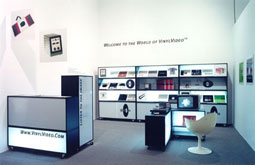Video on vinyl, corporate sabotage and a hidden collection of Net Art at the Venice Biennale di Lina Dzuverovic Russel

To this day, the art world and Internet related art practice have yet to find a language with which to talk to one other. Walking through this year's Venice Biennale in early June, you could have sworn that the Internet had never happened: finding sonic and visual art that reflected the impact of networked culture was extremely difficult. Representations of the complex non-object based arena of Net art, Net activism, digital music and video and streaming technology were few and far between, easy to miss amongst endless pavilions which opted for displays of more traditional artforms. Above all, the Biennale proved that the art establishment is still far from ready, or interested, in openly engaging with the multiplicity of artforms that have emerged from today's networked media. This lack of engagement meant that the few spaces that did exhibit the work of Net artists felt marginalised. Located a lengthy scooter-ride away from the main Biennale Ôcampus', these few spaces attracted only the most enthusiastic visitor willing to invest time and energy into seeking out new spaces.
One piece worth spending a considerable amount of time with was VinylVideo, an invention by Austrian artist Gebhard SengmŸller and various collaborators. Vinylvideo is an analogue/digital hybrid which makes it possible to store video footage on analogue LP records, consisting of a turntable hooked up to a television monitor via a special conversion box. Audience members could pick and play their favourite record at varying speeds, while reclining in a special branded viewing area in the corner. The contraption inspired a strange bout of nostalgia for an item you never had Ñ a missing link in the history of lo-fi equipment; the device that would have happily sat in your teenage bedroom between your Super-8 movie projector and your first Dansette record player.
A great deal of virtual art is geared towards disruption or destruction rather than creation. Renowned for having instigated acts of corporate sabotage via the Web (www.rtmark.com), and such plunderphonic recording projects as Deconstructing Beck, American Ôillegal artist' outfit ¨ªark's contribution was a poster mapping the collective's spoof corporate-styled formulas for economic disruption (such as ÔPhone In Sick Day'). In the Slovenian Pavilion, 0100101110101101.org and epidemiC had collaborated to produce a computer virus. The Ôbienale.py' virus was made public and spread over the Net on the opening day. Visitors to the Pavilion could test the effects of the virus on an infected computer in the gallery.
As it transpired, it was the exhibition at the Slovenian Pavilion and its satellite spaces that provided the one exception to the rule, by being filled with artists and groups currently active on the Net. Curated by Aurora Fonda, Slovenia presented the work of Vuk Cosic, Tadej Pogacar and 0100101110101101.org. If the world of Net art has a superstar, it's Vuk Cosic Ñ one of the few artists to be both a player in both the art world and Ôthe network' Ð a term used to describe the web of early practitioners who subsequently gave birth to Net art. Cosic was instrumental in founding key networks based around email lists such as Nettime, Seven-eleven, Syndicate and the Ljubljana based Ljudmila digital media lab. Using ASCII characters to create low-res images, he has produced a series of ASCII videos, including a reworking of Deep Throat and a series of makeshift pop promos to accompany Alexej Shulgin's group 386DX (including classics such as "California Dreaming" and "Should I Stay Or Should I Go").
In his Temporary
Autonomous Pavilion, Cosic included his own Instant ASCII Camera. Thereafter,
he invited the participation of a core group of artists synonymous with
the "heroic period of Net art", all of whom remain active
in the field: Heath Bunting, Vinyl Video, Tom Jennings, 0100101110101101.org,
Alexej Shulgin and ¨ªark, but strangely omitted works by numerous
female artists who were equally active at the time, making it almost
exclusively a male show. Exhibiting this work outside of its native
context Ñ the Net Ñ is problematic, but Cosic's exhibition,
skilfully adapted for an art crowd, is certain to go down in history
as the first major survey of Net art at an exhibition of this kind and
scale. Meanwhile, one of the few spaces that ventured away from traditional
forms was the Nordic Pavilion, a collaboration between artists from
Norway, Sweden and Finland. Curated by Tommi Gršnlund (of SŠhkš
Recordings) and Petteri Nisunen, the Nordic group led by CM Von Hausswolff
took as its starting point the architecture of the pavilion, a modernist
construction designed by Norwegian architect Sverre Fehn. Cleared out,
airy and predominantly white, the pavilion housed a number of discreet
interventions such as specially designed curtains and minimalist sculptures,
best experienced all at once. Disseminated around the room was the sound
of a specially constructed radio receiver picking up radio stations
on all frequencies. Walking across the space, you gradually became aware
of a series of almost undetectable changes, often so subtle that it
became difficult to be sure they actually happened. Playing with the
notion of the visible and the invisible, opaque glass screens suddenly
became transparent while the surprisingly harmonious ethereal radio
noise occasionally formed into barely distinguishable layers of spoken
word, music and commercials, creating a miraculous web of readymade
sounds floating across Europe and beyond.